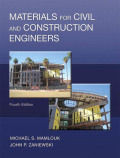
Three 150 mm × 300 mm concrete cylinders with water to cement ratios of 0.4, 0.6, and 0.8, respectively. After curing for 28 days, the specimens were subjected to increments of compressive loads until failure. The load versus deformation results were as shown in Table P7.29.
Assuming that the gauge length is the whole specimen height, it is required to do the following:
- a. The compressive stresses and strains for each specimen at each load increment.
- b. Plot stresses versus strains for all specimens on one graph.
- c. The ultimate strength for each specimen.
- d. The modulus of elasticity as the secant modulus at 40% of the ultimate stress for each specimen.
- e. The strain at failure for each specimen.
- f. The toughness for each specimen.
- g. Comment on the effect of increasing the water-cement ratio on the following:
- i. Ultimate strength
- ii. Modulus of elasticity
- iii. Ductility
- iv. Toughness. Curves may be approximated with a series of straight lines.
TABLE P7.29
| Specimen No. | |||
| 1 | 2 | 3 | |
| w/c Ratio | 0.4 | 0.6 | 0.8 |
| Deformation (mm) | Load (kN) | ||
| 0 | 0 | 0 | 0 |
| 0.3 | 514 | 348 | 244 |
| 0.6 | 853 (failure) | 472 | 304 |
| 0.9 | 433 (failure) | 263 | |
| 1.2 | 235 (failure) | ||
Want to see the full answer?
Check out a sample textbook solution
Chapter 7 Solutions
EBK MATERIALS FOR CIVIL AND CONSTRUCTIO
Additional Engineering Textbook Solutions
INTERNATIONAL EDITION---Engineering Mechanics: Statics, 14th edition (SI unit)
Mechanics of Materials (10th Edition)
Introduction To Programming Using Visual Basic (11th Edition)
Concepts Of Programming Languages
Web Development and Design Foundations with HTML5 (8th Edition)
Computer Science: An Overview (13th Edition) (What's New in Computer Science)
- 8-18. Determine the vertical displacement of joint C if member CD is fabricated 10 mm too long. 4m D E B Carrow_forward8-17. Determine the vertical displacement of joint C if members AB and BC experience a temperature increase of ST = 50°C. Take a = 12(10-6)/°C. A 4 m E 4 m 4 m B Darrow_forwardPlease solve all pointsarrow_forward
- For the I section prestressed concrete beam with a straight tendon shown in Fig below which is under the prestressing force, and U.D.L. Analyze the stresses at Mid- span at: A- transfer stage (due to initial prestress P. and self weight wo) B- at service stage. (due to effective prestress Pe and full loads) Check stresses with the ACI permissible stresses. Given: Initial prestress force Pi = 750 kN Effective prestress force Pe = 640 kN Wo (self) = 2.7 kN/m = W (D+L) 8 kN/m e = 130 mm I 5 10 mm² fci = 25 MPa (at transfer age), f' = 35 MPa (at service age) ASECTION 114 000 mm² W=4.75 kN/m |- 12 m F I 610mmarrow_forwardKindly help to provide explanation, examples and provide any useful link for citations and learning purposes. This is regarding building diagnosis.arrow_forwardDescribe the scientific of the arrival of enslaved Africans in America and how it has impacted American societyarrow_forward
- For the beam of cross section shown below, analyze the stresses at Mid-span at transfer and at service stages, Neglect losses. Use: f' =41.4 MPa and assume that concrete has attained strength of fci =34.5 MPa at the time of transfer. The initial prestress force is (Psi-1112 kN). The service deal load D.L = 3.65 kN/m (not include self weight of beam). The service live load L.L=14.6 kN/m. Use n=7. Check stresses with the ACI permissible stresses Determine the equivalent transformed section in compute A and I h=508 mm d=381 9.15 As= 1290 mm² 305arrow_forwardFor the prestressed concrete beam with a straight tendon shown in Fig below which is under the prestressing force of 1620 kN, Analyze the stresses at Mid-span at transfer stage. The uniformly distribution load (self weight) = 4.75 kN/m. Then draw the stress distribution across the section mid-span. W=4.75 kN/m Δ 7.3 m F= 1620 kN 750 mm I 230 mm 500 mmarrow_forward4.36 A pipe slopes upward in the direction of liquid flow at an angle of 30° with the horizontal. What is the pressure gradient in the flow direction along the pipe in terms of the specific weight of the liquid, y, if the liquid is decelerating (accelerating opposite to flow direction) at a rate of 0.3 g?arrow_forward
- 4.25 In this flow passage, the velocity is varying with time. The velocity varies with time at section A-A as 4m V-41/1-230/1 2.25- S to At time t = 0.50s, it is known that at section A-A the velocity gradient in the s direction is +2.1 m/s per meter. Given that to is 0.6 s and assuming quasi-1-D flow, answer the following questions for time t = 0.5 s: a. What is the local acceleration at A-A? b. What is the convective acceleration at A-A? A Diameter 50 cm Problem 4.25arrow_forwardCan you design a (Open Channel): -Most Efficient Section (Rectangle Shape) -Cost Estimate -Structural Analysis Design Requirements: Bed Slope= 1:1500 Manning's (n)= 0.015 Discharge: Q= 18 m^3/sarrow_forwardWhat is Highway engineeringarrow_forward
 Traffic and Highway EngineeringCivil EngineeringISBN:9781305156241Author:Garber, Nicholas J.Publisher:Cengage Learning
Traffic and Highway EngineeringCivil EngineeringISBN:9781305156241Author:Garber, Nicholas J.Publisher:Cengage Learning Materials Science And Engineering PropertiesCivil EngineeringISBN:9781111988609Author:Charles GilmorePublisher:Cengage Learning
Materials Science And Engineering PropertiesCivil EngineeringISBN:9781111988609Author:Charles GilmorePublisher:Cengage Learning Steel Design (Activate Learning with these NEW ti...Civil EngineeringISBN:9781337094740Author:Segui, William T.Publisher:Cengage Learning
Steel Design (Activate Learning with these NEW ti...Civil EngineeringISBN:9781337094740Author:Segui, William T.Publisher:Cengage Learning Construction Materials, Methods and Techniques (M...Civil EngineeringISBN:9781305086272Author:William P. Spence, Eva KultermannPublisher:Cengage Learning
Construction Materials, Methods and Techniques (M...Civil EngineeringISBN:9781305086272Author:William P. Spence, Eva KultermannPublisher:Cengage Learning Fundamentals of Geotechnical Engineering (MindTap...Civil EngineeringISBN:9781305635180Author:Braja M. Das, Nagaratnam SivakuganPublisher:Cengage Learning
Fundamentals of Geotechnical Engineering (MindTap...Civil EngineeringISBN:9781305635180Author:Braja M. Das, Nagaratnam SivakuganPublisher:Cengage Learning Fundamentals Of Construction EstimatingCivil EngineeringISBN:9781337399395Author:Pratt, David J.Publisher:Cengage,
Fundamentals Of Construction EstimatingCivil EngineeringISBN:9781337399395Author:Pratt, David J.Publisher:Cengage,





